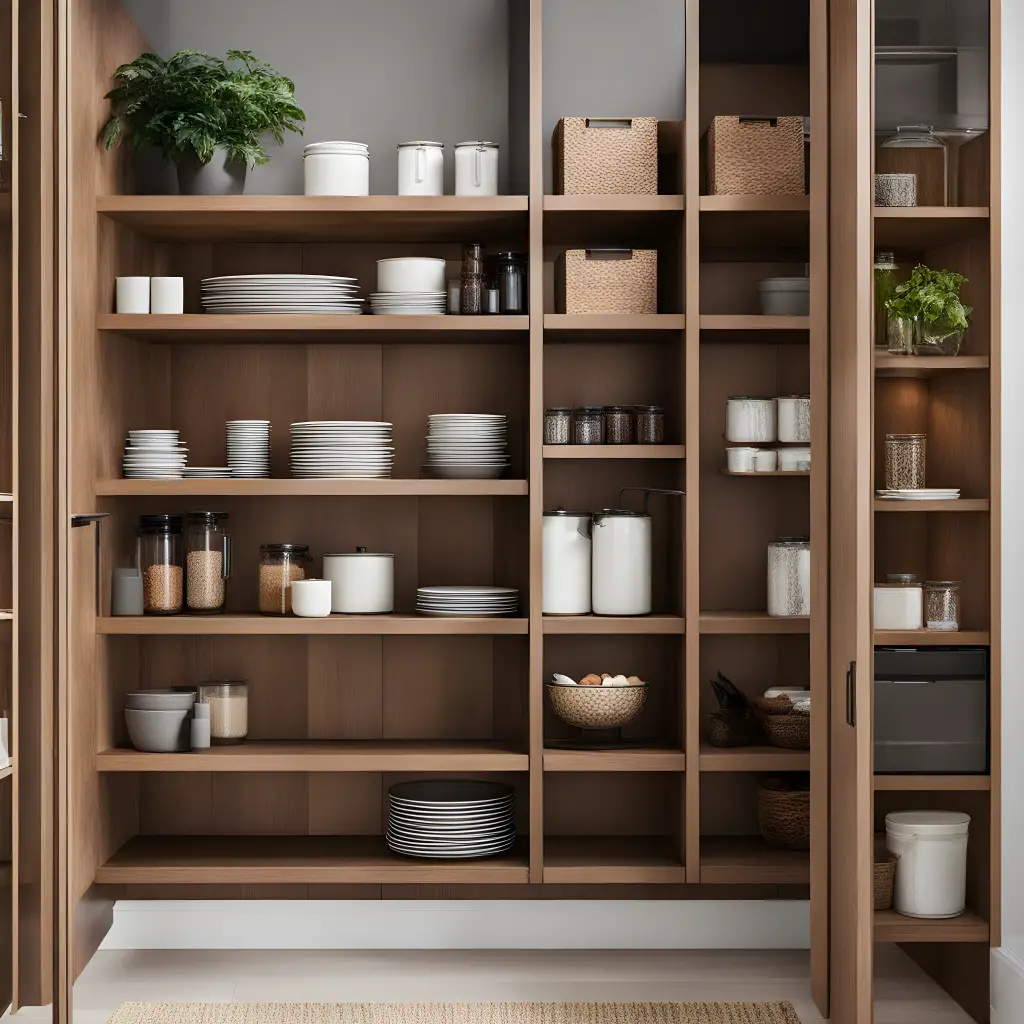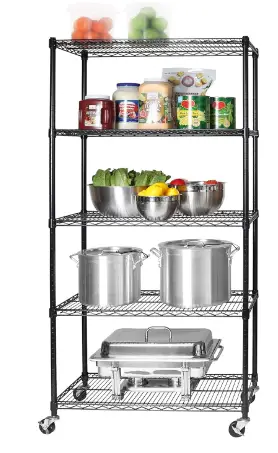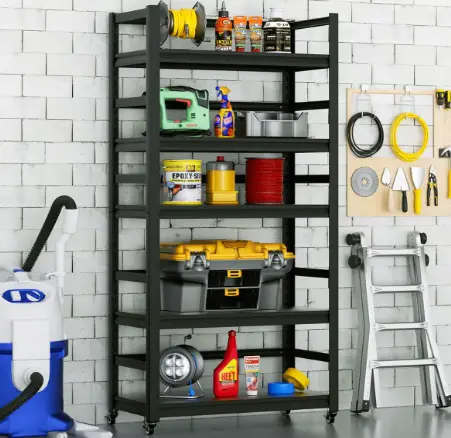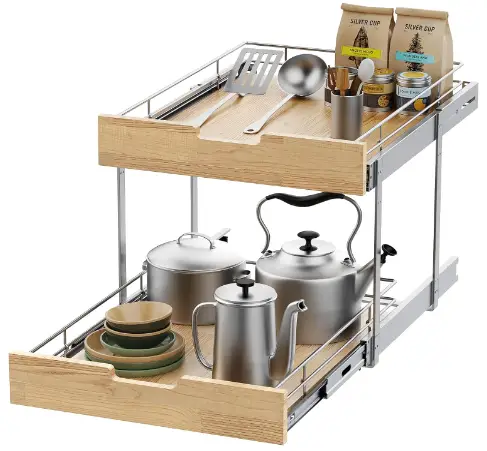
Are you tired of your pantry being a disorganized mess? Do you struggle to find the ingredients you need when you’re cooking? It may be time to invest in some new shelving for your pantry.
With the right shelving, you can maximize your pantry’s storage space and keep everything neatly organized. But with so many options available, how do you know which type of shelving is best for your pantry?
In this article, we will explore five different types of shelving that are perfect for pantries, so you can choose the one that works best for your needs.
What Is The Best Shelving For A Pantry?
One popular option for pantry shelving is wire shelving. These shelves are durable, easy to install, and allow for good air circulation, which can help keep your food fresher for longer. They also come in a variety of sizes, so you can customize your pantry to fit your specific needs.
Another option is floating shelves. These shelves are mounted directly onto the wall, giving your pantry a sleek and modern look. They are great for small spaces, as they don’t take up much room and can be placed at any height you desire. Whether you have a small pantry or a large one, there is a shelving option that will work perfectly for you.
1. Wire Shelving
If you’re looking for a pantry shelving option that’s versatile and easy to install, wire shelving is the way to go! One of the main benefits of wire shelving in organizing pantry items is its adjustable nature. With wire shelving, you can easily move the shelves up or down to accommodate items of different heights. This allows you to maximize the vertical space in your pantry and make the most of every inch.
Additionally, the open design of wire shelves allows for better visibility of your pantry items. You can easily see what you have and quickly grab what you need without having to search through cluttered shelves.
When it comes to installing wire shelving in a pantry space, there are a few tips to keep in mind. First, make sure to measure the dimensions of your pantry accurately before purchasing the wire shelving. This will ensure that you get the right size and avoid any unnecessary hassle.
Next, it’s important to secure the wire shelving properly to prevent any accidents or damage. Use wall anchors or brackets to securely attach the shelves to the walls of your pantry.
Lastly, consider using additional accessories such as shelf liners or dividers to further optimize the organization of your pantry items. These simple additions can help prevent items from falling through the wire shelves and provide extra support for your items.
2. Floating Shelves
You’ll love how floating shelves add a modern and stylish touch to your pantry. They not only provide a sleek and minimalistic look, but they also create the illusion of more space. With floating shelves, there are no visible brackets or supports, giving your pantry a clean and streamlined appearance.
Here are some pros and cons of installing floating shelves in your pantry:
- Pros:
- Versatility: Floating shelves come in various sizes and materials, allowing you to customize them according to your pantry’s needs and your style.
- Easy to clean: Since there are no brackets or supports, cleaning the shelves becomes a breeze. You can simply wipe them down without any obstructions.
- Accessibility: Floating shelves make it easy to see and access all your pantry items. You won’t have to dig through deep cabinets or struggle to find what you need.
- Cons:
- Weight limitations: Floating shelves are not as sturdy as other shelving options, so they have weight limitations. It’s important to consider the weight of the items you plan to store on them and choose accordingly.
- Installation: Installing floating shelves can be a bit more challenging compared to other shelving options. It requires precise measurements, proper wall anchoring, and careful leveling to ensure they are securely mounted.
To install floating shelves in your pantry, follow these tips:
- Measure and mark the desired height and spacing for your shelves on the wall.
- Use a stud finder to locate the studs in the wall. It’s important to anchor the shelves to the studs for stability.
- Install wall anchors or use toggle bolts for additional support if there are no studs in the desired locations.
- Mount the shelf brackets on the wall, making sure they are level and securely attached.
- Place the floating shelves on top of the brackets and secure them in place with screws or adhesive, following the manufacturer’s instructions.
Their modern aesthetic and functional design make floating shelves a great addition to your pantry. Consider the pros and cons, and follow the installation tips to enjoy their benefits.
3. Adjustable Shelving Units
When it comes to organizing your kitchen storage, adjustable shelving units are a game-changer. These versatile shelves allow you to customize the height and spacing between each shelf, ensuring that you can accommodate items of all sizes and shapes.
The installation process is relatively straightforward, with most units being easily adjustable and requiring minimal tools. Simply measure the height and width of your pantry and choose a shelving unit that fits your space. Once you have the unit, follow the manufacturer’s instructions to assemble and adjust the shelves to your desired configuration.
The benefits of adjustable shelving are numerous. Firstly, they maximize the use of vertical space in your pantry, making it easier to store more items without cluttering your shelves. By adjusting the height of each shelf, you can create additional storage space for taller items, such as cereal boxes or bottles.
Additionally, adjustable shelving allows for easy reconfiguration as your storage needs change over time. Whether you need to make room for larger items or reorganize your pantry to accommodate new groceries, these shelves can be quickly adjusted without the need for any specialized tools.
With adjustable shelving units, you’ll have a pantry that is not only organized but also adaptable to your ever-changing storage needs.
4. Pull-Out Shelves
To make your kitchen storage even more efficient and convenient, consider installing pull-out shelves in your cabinets. Pull-out shelves offer numerous benefits for organizing your pantry.
First and foremost, they provide easy access to all your items. No more rummaging through stacks of cans or boxes to find what you need. With pull-out shelves, everything is within reach and visible, making it a breeze to locate and retrieve items.
Additionally, these shelves allow you to maximize your storage space. You can fully utilize the depth of your cabinet by pulling out the shelf and accessing items at the back without any hassle. This is especially useful for deep pantry cabinets where items tend to get lost or forgotten at the back. With pull-out shelves, every inch of space is utilized, providing you with more storage capacity.
To further maximize your storage space with pull-out shelves, consider using dividers or bins. These can help you categorize and sort your items, making it easier to find what you need. You can separate different types of food, such as snacks, canned goods, or spices, using dividers or bins. This not only keeps your pantry organized but also prevents items from toppling over when you pull out the shelf.
Another trick to maximize storage is to install pull-out shelves on both sides of your pantry. This way, you can access items from either side, ensuring efficient use of space. Lastly, don’t forget to measure your pantry and choose pull-out shelves that fit perfectly. Customizing the shelves to your pantry’s dimensions will ensure that you make the most of your storage space and have a well-organized pantry.
5. Cabinet-Style Shelving
Cabinet-style shelving transforms your kitchen storage by creating a sleek and modern display of your items. With its clean lines and hidden storage, cabinet-style shelving offers a sophisticated and organized look for your pantry.
One of the main advantages of this type of shelving is its ability to hide clutter and keep your pantry looking tidy. The cabinets provide ample space for storing various items, from canned goods to spices, and keep them out of sight, giving your pantry a streamlined appearance.
However, there are also some downsides to consider when choosing cabinet-style shelving. One drawback is that it may be more expensive compared to other shelving options. The cost of purchasing and installing cabinets can be higher than other types of shelving, especially if you opt for custom-made cabinets.
Additionally, cabinet-style shelving may not be as easily accessible as other options. Since the shelves are enclosed within the cabinets, you may need to open and close the doors to reach the items you need, which can be a hassle when you’re in a hurry.
To choose the right cabinet-style shelving for your pantry, consider your storage needs and the size of your space. Assess the amount and types of items you need to store and ensure that the shelving can accommodate them all. Additionally, measure your pantry to determine the dimensions of the cabinets you need.
Consider the style and design of the cabinets as well, as they should complement the overall aesthetic of your kitchen. Lastly, take into account your budget and choose a cabinet-style shelving option that fits within your price range.
What Type of Shelves Are Best in a Pantry?

Types of Pantry Shelves
Pantry shelves come in various styles, including adjustable wire shelves, fixed wooden shelves, and pull-out shelves. The choice largely depends on your pantry’s size and your storage needs. Adjustable wire shelves offer flexibility, fixed wooden shelves provide sturdiness, and pull-out shelves maximize accessibility.
Best Materials for Pantry Shelves
For longevity, consider materials like solid wood or wire shelving with a durable finish. Solid wood shelves have a classic look and are ideal for smaller pantries. Wire shelving, on the other hand, allows for better ventilation and is perfect for larger pantries.
Size and Depth
Shelf size and depth vary. Standard pantry shelves are typically 16 inches deep. However, if you have a deep pantry, opt for 20–24-inch shelves. Adjustable shelving allows you to customize the height to accommodate various items, from canned goods to tall cereal boxes.
How High Should Shelving Be for a Pantry?
Finding the Right Height
The ideal height for pantry shelves depends on your needs and the items you intend to store. Consider keeping the lower shelves closer to the ground for easy access to heavy items. Upper shelves can be reserved for lighter items and seasonal goods.
Measuring for Height
Measure the tallest items you plan to store in your pantry, such as large jars or appliances. Ensure there’s enough clearance for these items. Typically, a distance of 12-18 inches between shelves works well for most pantries.
Standard Shelf Heights
In most pantries, standard shelf heights range from 14 to 18 inches. These measurements work well for storing common pantry items like canned goods, jars, and small kitchen appliances. It’s a versatile height that ensures efficient storage without wasting space.
Taller Shelves for Larger Items
If you have bulkier items or appliances to store, consider installing a few taller shelves. These can be as high as 24 inches and are perfect for items like stand mixers, blenders, or large kitchen containers. By mixing standard and taller shelves, you can cater to a variety of items.
Consider the Reach
When deciding on shelf heights, it’s essential to think about the reachability of items. Place frequently used items on shelves that are easily accessible. Store items you don’t need as often on higher or lower shelves.
What Is the Best Use of Deep Pantry Shelves?
Making the Most of Deep Pantry Shelves
Deep pantry shelves are fantastic for storing a lot of items, but they can become chaotic if not organized properly. Let’s explore how to make the best use of these shelves.
Use Bins and Baskets
Deep shelves can lead to items getting lost at the back. Utilize bins and baskets to group similar items and make them more accessible. For example, designate one bin for canned goods, another for snacks, and so on.
Label Everything
Labeling is your best friend in a deep pantry. Clearly mark the contents of each bin or basket. This not only makes it easier to find what you need but also helps keep your pantry organized in the long run.
Slide-Out Organizers
Consider installing slide-out organizers for deep pantry shelves. These organizers function like drawers, allowing you to pull out the entire shelf for easy access to items stored in the back. They are especially handy for items like pots, pans, or appliances.
How to Build Shelves for a Pantry
Step-by-Step Guide
If you want to create custom shelves for your pantry, here’s a step-by-step guide to get you started:
- Measure Your Space: Measure the dimensions of your pantry to determine the size and number of shelves you’ll need.
- Choose Your Material: Opt for sturdy materials like plywood, MDF, or melamine.
- Cut the Shelves: Cut your chosen material to the desired size. If you’re not comfortable with this, many home improvement stores can cut them for you.
- Install Shelf Brackets: Attach shelf brackets to the pantry walls, making sure they’re level and secure.
- Place the Shelves: Rest the shelves on top of the brackets and secure them in place.
- Add a Front Lip: For deep shelves, consider adding a front lip to prevent items from falling.
- Paint or Finish: If desired, paint or finish the shelves to match your pantry’s aesthetics.
Frequently Asked Questions
What is the ideal spacing between pantry shelves?
The ideal spacing is typically 12-18 inches, but you should adapt it to fit your specific needs and the items you’ll store.
Can I use adjustable shelves in a small pantry?
Yes, adjustable shelves can work in small pantries, allowing you to customize the space to your needs.
What’s the best way to organize deep pantry shelves?
Use storage bins, labels, and a systematic approach to keep deep pantry shelves organized and efficient.
Do I need carpentry skills to build pantry shelves?
Not necessarily. You can design and install simple pantry shelves with basic tools and materials from a home improvement store.
Where can I find quality pantry shelving materials online?
You can explore a variety of options on websites like Amazon, Home Depot, or Lowe’s for quality pantry shelving materials.
Can I repurpose old furniture for pantry shelving?
Absolutely! Repurposing old bookshelves, cabinets, or other furniture can be a creative and sustainable way to create pantry shelving.
Conclusion
The right pantry shelves can transform your kitchen’s organization and efficiency. By choosing the appropriate type of shelves, and the ideal height, and understanding the best use of deep shelves, you’ll be well on your way to a more functional pantry. If you’re up for a DIY project, building your pantry shelves can be a rewarding experience.
In this comprehensive guide, we’ve covered the ins and outs of pantry shelving, ensuring that you have all the knowledge you need to optimize your pantry space. Remember, the key is to adapt these guidelines to your unique needs and preferences. Happy organizing!
What is the best shelving for a Pantry? When it comes to finding the best shelving for your pantry, there are several options to consider.
- Wire shelving is a popular choice as it’s sturdy, affordable, and allows for good air circulation.
- Floating shelves can add a modern and sleek look to your pantry while providing ample storage space.
- Adjustable shelving units provide flexibility, allowing you to customize the shelves to fit your specific needs.
- Pull-out shelves are a great option for maximizing space and easy access to items at the back of your pantry.
- Finally, cabinet-style shelving can offer a more traditional and organized look to your pantry.
Ultimately, the best shelving for your pantry will depend on your personal preferences, the size of your pantry, and the items you plan to store.
It’s important to consider factors such as durability, functionality, and aesthetics when making your decision.
Additionally, it may be helpful to assess your pantry’s layout and storage needs before selecting the appropriate shelving solution.
By carefully considering these factors, you can find the best shelving option that’ll help keep your pantry organized and efficient.





